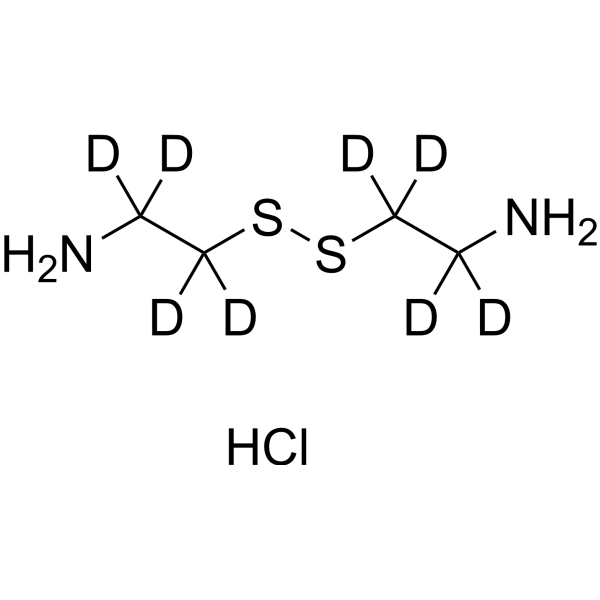Cystamine-d8 (dihydrochloride)
Modify Date: 2024-01-11 16:20:37

Cystamine-d8 (dihydrochloride) structure
|
Common Name | Cystamine-d8 (dihydrochloride) | ||
|---|---|---|---|---|
| CAS Number | 2712126-51-5 | Molecular Weight | 196.79 | |
| Density | N/A | Boiling Point | N/A | |
| Molecular Formula | C4H5D8ClN2S2 | Melting Point | N/A | |
| MSDS | N/A | Flash Point | N/A | |
Use of Cystamine-d8 (dihydrochloride)Cystamine-d8 (dihydrochloride) is the deuterium labeled Cystamine (dihydrochloride)[1]. Cystamine (dihydrochloride) is the disulfide form of the free thiol, cysteamine. Cystamine is an orally active transglutaminase (Tgase) inhibitor. Cystamine also has inhibition activity for caspase-3 with an IC50 value of 23.6 μM. Cystamine can be used for the research of severals diseases including Huntington's disease (HD)[2][3][4]. |
| Name | Cystamine-d8 (dihydrochloride) |
|---|
| Description | Cystamine-d8 (dihydrochloride) is the deuterium labeled Cystamine (dihydrochloride)[1]. Cystamine (dihydrochloride) is the disulfide form of the free thiol, cysteamine. Cystamine is an orally active transglutaminase (Tgase) inhibitor. Cystamine also has inhibition activity for caspase-3 with an IC50 value of 23.6 μM. Cystamine can be used for the research of severals diseases including Huntington's disease (HD)[2][3][4]. |
|---|---|
| Related Catalog | |
| In Vitro | Stable heavy isotopes of hydrogen, carbon, and other elements have been incorporated into drug molecules, largely as tracers for quantitation during the drug development process. Deuteration has gained attention because of its potential to affect the pharmacokinetic and metabolic profiles of drugs[1]. |
| References |
| Molecular Formula | C4H5D8ClN2S2 |
|---|---|
| Molecular Weight | 196.79 |